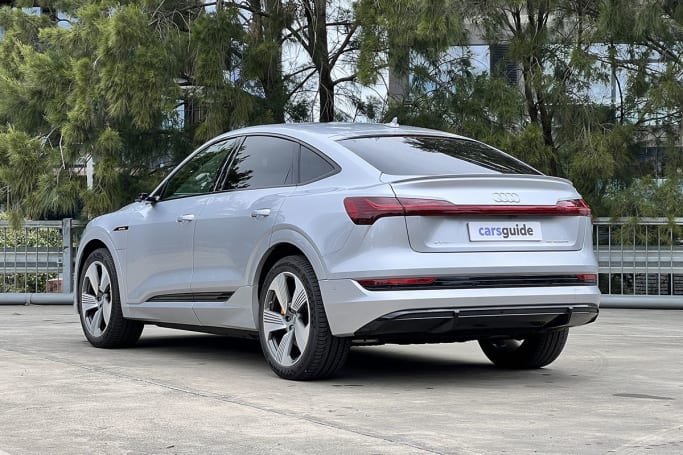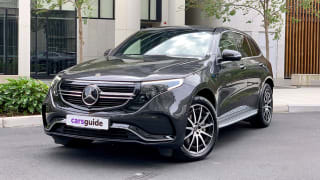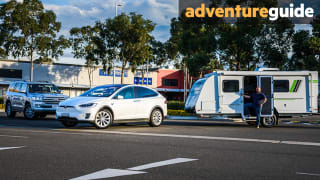First things first, the e-tron Sportback you see here is a 55 First Edition, which was aptly part of the large SUV’s MY20 launch line-up that’s been superseded since arriving in September 2020. Limited to 70 units, it was priced from $169,950 plus on-road costs.

Rivals for the e-tron Sportback are currently few and far between, but the Tesla Model X (from $189,159) is a formidable foe, while the BMW iX (from $135,900) is due in the first quarter of 2022, and the Mercedes-Benz EQE SUV is yet to be revealed.
But you’re probably wondering why we’re testing the 55 First Edition instead of a MY22 e-tron Sportback, and the simple answer is this is the vehicle Audi Australia was able to supply to us in Melbourne.
If you’re keen on a MY22 e-tron Sportback 55 after reading this long-term review, it costs $157,100 (at the time of writing), although you’d have to option it up to come close to matching the specification of the First Edition – if that’s what you’re after.
Speaking of standard equipment, let’s kick this long-term review off by exploring what e-tron Sportback 55 First Edition buyers received for their money.
In fact, let’s get straight to the point: the First Edition – and every other e-tron Sportback 55 – comes with a liquid-cooled 95kWh lithium-ion battery offering a solid 446km of WLTP-certified range. For reference, the entry-level 50 (from $148,100) has a 71kWh unit that lasts 347km.
Needless to say, the smart money is on the 55 flagship, with its $9000 premium arguably worth it to ease any range anxiety. Better yet, its dual-motor powertrain develops a more promising 300kW of power and 664Nm of torque, compared to the 50’s 230kW/540Nm.

Either way, a version of Audi’s signature quattro all-wheel-drive system is fitted, with the 55 able to use overboost (activated by putting the single-speed automatic transmission in Sport) to sprint from a standstill to 100km/h in 5.7 seconds, with the 50 left 1.1s behind.
But we digress… because you no doubt want to hear more about the 55’s range, particularly in the real world, as well as what it’s like to charge.
Before we get into all that, I have an important confession to make. I’ve been living in locked-down metropolitan Melbourne since we collected the First Edition from the Audi Brighton service centre.
That means I haven’t been able to travel outside of my 5.0km radius in the first month of ‘ownership’ – excluding the time I drove to the other side of town to get my first COVID-19 vaccination.
Point being, I only travelled 184km in my first four weeks with the 55. And no, that’s not a misprint. Here’s hoping for a more productive second month, although my hopes aren’t particularly high…

It goes without saying, then, that I haven’t really had a need to charge the First Edition so far, although I made a point of doing so for this instalment of the long-term review.
Again, I don’t have any home charging options due to living in an apartment building with a dedicated parking spot that doesn’t have a power outlet nearby.
I, therefore, have had to turn to public charging options, and thankfully for me, I live just 600m from a 50kW DC fast charger (with the required CCS plug type) that’s free to use.
It’s operated by ChargePoint, which has an app that conveniently shows availability.
In my shared Leaf long-term review, my struggles with this particular 50kW DC fast charger were well-documented, but ChargePoint seems to have addressed its reliability issues since then, as the charging process was relatively pain-free this time around.

I went for a nice long walk while the 55 was juicing up, with its battery capacity sitting at 28 per cent when the charge started. When I returned, I realised it hadn’t charged past 80 per cent, so I can’t tell you how long it took.
Apparently, ChargePoint has software-locked that 50kW DC fast charger to not give users their final 20 per cent of charge, likely due to the related parking spot being time-limited to just one hour. A slightly disappointing outcome, but good to know for next time.
When it came to the First Edition’s energy consumption for the first month, it averaged 30.8kWh/100km, which is well above the claimed 22.7kWh/100km. For reference, that equates to just 308km of range from a full battery.
My (very) short, sharp trips to the shops and back were no doubt a factor in the poor result, so we’ll reserve full judgement for later on, when I should be able to drive the 55 in a more regular manner.
That said, one of the genuine perks of owning an EV is their longer service intervals, with the e-tron Sportback only requiring servicing every 24 months or 30,000km.
And to sweeten the deal even further, Audi Australia covers the first three visits to an authorised service centre and throws in six years of roadside assistance.
Along with the free six-year ‘unlimited’ membership to Australia’s largest EV charging network, Chargefox, that’s one compelling aftersales package – and so it should be at this price point, frankly.
However, disappointingly the e-tron Sportback still comes with Audi Australia’s regular three-year/unlimited-kilometre warranty, even if the battery is covered by a separate eight-year/160,000km term.

I’ll discuss the 55’s practicality and how it drives (including the performance of its advanced driver-assist systems) in detail in the next two parts of this long-term review, but in this instalment, I’d like to bring attention to just how lovely it is around town.
Being an EV, the First Edition is near silent in its operation, but it’s also very comfortable thanks to its air suspension’s low-speed prowess (even with the 21-inch alloy wheels) and its electric power steering’s light tune.
The 55 also has plenty of get up and go for those short bursts of acceleration in city traffic, with that instantaneous 664Nm wad of torque capable of shoving its occupants into their seats time and time again. I just wish there was a ‘one-pedal’ regenerative braking setting.
The cabin is also a wonderful place to spend time, feeling genuinely premium thanks to the First Edition’s pumping 705W Bang & Olufsen 3D sound system, supple Valcona leather upholstery, aluminium trim and sporty Alcantara door inserts.

And then there’s the 55’s 10.1- and 8.6-inch touchscreens with haptic feedback, which actually work pretty well, with the centre stack’s lower display wisely dedicated to the climate controls, while the 12.3-inch digital instrument cluster is predictably brilliant.
Yep, it’s been a pretty good overall experience so far, but one of my few gripes is arguably the First Edition’s big party trick, the ‘digital’ side mirrors. No, your eyes do not deceive you, there are no traditional side mirrors to be seen here.

Instead, the two aerodynamically friendly stalks are fitted with high-quality cameras that a send a live feed inside to a pair of 7.0-inch OLED touchscreens positioned in the top corners of the front doors.
The set-up feels very unnatural at first and doesn’t really get much better after that as the driver (and passengers) place a lot of trust in the adjustable view they’re given. And you also lose most of your peripheral vision as you must look down instead of just across. Strange.

Hopefully, the digital side mirrors become second nature over a longer period of time – I’ll see you next month to find out.
Acquired: August 2021
Distance travelled this month: 184km
Odometer: 6491km
Average energy consumption for August/September: 30.8kWh/100km




























